#toyota Century SUV
Explore tagged Tumblr posts
Video
youtube
All New Toyota CENTURY SUV Launch #century #toyota #toyotacentury
0 notes
Video
youtube
2025 Toyota Century SUV Ideal Design
0 notes
Text
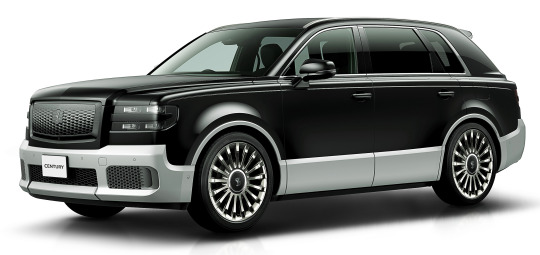
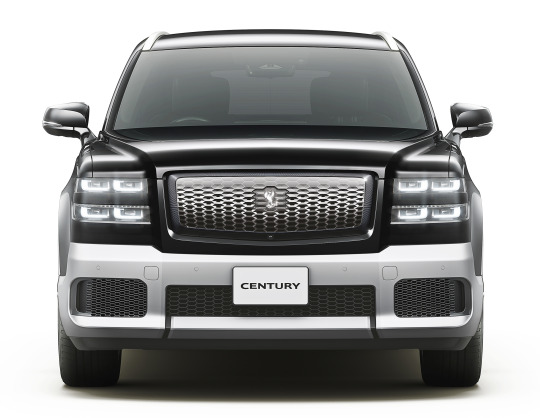



Century, 2024. Toyota have revealed their new super-luxury SUV which is the first time they have used their Century model name on anything other than a luxury saloon/limousine. The SUV is aimed squarely at the chauffeur-driven market which Toyota says has evolved as passengers seek to “utilize” their time on the road more effectively by resting or participating in online meetings. It is powered by a 406hp 3.5-litre V6 plug-in hybrid powertrain including an e-CVT gearbox and E-Four Advanced AWD system. With an electric range of 70Km the SUV can behave like a BEV in the city, transitioning to an HEV for longer journeys. The vehicle is simply badged Century, with a phoenix emblem replacing all Toyota badges.
#Century#Toyota Century#new cars#SUV#4x4#luxury SUV#hybrid#V6 Hybrid#luxury car#4-seater#chauffeur driven#phoenix#2024#2020s#CVT
217 notes
·
View notes
Text
WHAT WHITE CALF POV CHARACTERS WOULD DRIVE IF THEY LIVED IN THE 21ST CENTURY URBAN USA REAL LIFE
Couya: A gray Land Rover Defender, the perfect vehicle for physically intimidating anyone who has the audacity to go less than 15mph over the speed limit.

Janeys: A light blue Toyota Prius, driven about as aggressively as a Prius is physically capable. Has a mysterious Land Rover Defender shaped indentation in the rear bumper.

Faiza: White Volvo SUV that has an enthralling collection of Jesus fish, 'don't tread on me' snake, and 'I'm with Her' stickers.

Brakul: Old hand-me-down Ford F150 that he almost never uses, but he refuses to sell or scrap it so it's mostly left sitting around on the street with deflated tires and gets impounded like, three to five times a year on average.

Hibrides: Lime green Kia Soul with cigarette burns on the driver's seat. In a beautiful representation of polarity, this is kept rigorously clean and yet is somehow also perpetually filled with cat hair.

Tigran: by sheer improbable coincidence, an exact 1:1 match of the Susuki Esteem from Better Call Saul.

Palo: Just rides a fucking bicycle
#This post has been in my drafts for like 6 months and now that I've drawn a speculative modern AU I feel it's appropriate to drop#I think this was originally made somewhat as a vent post after a woman in a land rover defender tailgated me in a blizzard for like#3 miles straight while I was just trying to like survive
74 notes
·
View notes
Text
modern car design has honestly gone to shit
one reason is that it is now cheaper to put touchscreens, servos, and just screens in general than it is to actually engineer a properly working mechanical system, despite those being around for a literal century now
what's with the "one screen in the middle that controls everything" design philosophy anyways? "we want our drivers to look away from the road" is not. y'know. safe
the futuristic aspect also draws in buyers and (probably) investors, which makes it easier to fund projects. because futurism is better. these cars don't need to last!
and that's another problem: cars, ICE and EV, are not really built to last anymore. yes, all vehicles have a lifetime that they are rated for, but honestly it feels like it's getting shorter. or maybe consumerism has something to do with it: you always need to buy the newer and better car.
driving habits also do have something to do with it though, short commutes with lots of starting/stopping the engine do wear out parts faster. a lot of modern cars have the ability to turn off the engine while at a standstill, which does help increase fuel efficiency at the detriment of the engine
EVs do have drops in battery performance/capacity over time, which doesn't help
shifters are also changing. a lot. i mean, some are definitely cool, and I don't mind things like the BMW shifters that are just an automatic but fancy looking:

but then you have uh. well. tesla. with the touchscreen shifter. ok then

also they have the backup shift buttons. on the ceiling. yeah.
and their turn signals suck. that's enough dunking on tesla for this post. but do continue to dunk on tesla. especially the 6000+ lb. deathtrap called the cybertruck
which actually leads into the next point, big dumb trucks (and the general size increase of cars/the move towards SUVs and crossovers, but mainly the trucks). you know what they are. the giant trucks that have hoods taller than most sedans. that had that beautiful graphic of having worse sight lines than a main battle tank

safe for everyone, you see? they exist because of EPA regulations, after a certain size you're a work truck and less subject to regulations. and also the regulations on small vehicles are much higher than larger ones, in terms of like power to weight. so its a lot easier to make big than make small
most of them are pavement princesses anyways
repeal the chicken tax though, bring in light truck competition from overseas manufacturers. i want my kei trucks/cars (although that's the 25 year import law)

SUVs are painted as being safer, but actually have a higher center of gravity and are more prone to rolling over. they are safer though, cause they have more mass, which means what you hit gets damaged more and you get damaged less.
crossovers are weird cause they kind of can skirt regulations? not sure how they work
you can bypass some regulations with the "SUV overbite." give yourself a good approach angle, and now you're not a passenger vehicles and aren't subject to as many regulations. consequence is you look like this (sorry lexus)

electronic handbrakes. what. it makes sense, somewhat, but also manual handbrakes work perfectly well and are far less prone to failure (also drifting but)
push to start. i mean, it's not all bad, but keys are fun. give me keys. manual is better (although not necessarily for transmissions). don't be constantly emitting a signal that can be copied to steal a car. tesla i'm looking at you. a lot in this
i will say that not all digital displays are created equal. as far as i'm concerned, toyota/lexus have some very beautiful gauge clusters:

spicy, sleek, dare i say sexy, and they trickled down from the lexus LFA, which had a 9k rpm redline and got to that so fast they had to make a new digital cluster just to keep up. wild stuff. plus it's not too in your face and still has some mechanical components. nice
honestly no idea where i was going with this, but:
modern car design is getting worse because of futurism, trying to keep costs down, and poorly written/considered regulations
Touchscreens do not belong in cars
136K notes
·
View notes
Text
Hybrid vehicles: Promoting sustainable advancement in the automotive sector.
In the last few years, the worldwide car industry has experienced a significant change, highlighted by an increasing focus on sustainability and environmental awareness. In the face of growing worries about climate change and decreasing fossil fuel supplies, hybrid cars have become a crucial answer, providing a combination of fuel efficiency, lower emissions, and cutting-edge technology. As we deal with the intricacies of contemporary transportation, it is becoming more and more clear that hybrid vehicles are having a major impact on determining the future of the automotive industry.
Hybrid Technology's Development
The origin of hybrid vehicles can be dated back to the late 1800s, when early trials aimed at merging internal combustion engines and electric motors. Nonetheless, it wasn't until the beginning of the 21st century that hybrid cars gained widespread popularity, primarily because of groundbreaking initiatives by major companies such as Toyota and Honda.
The release of the Prius by Toyota in 1997 was a significant moment in the history of cars, demonstrating how hybrid technology could achieve great fuel efficiency while still offering strong performance. Hybrid drivetrains have since experienced substantial evolution, marked by improvements in battery technology, regenerative braking systems, and advanced engine management algorithms.
Advantages of Hybrid Vehicles
Hybrid vehicles provide numerous benefits, with the most important being their capacity to lower fuel usage and greenhouse gas emissions. Hybrids can conserve fuel and reduce pollutants by smoothly combining electric motors with traditional engines, allowing them to run on electric power at low speeds, in stop-and-go traffic, and while idling.
Furthermore, hybrid cars provide improved driving experiences with smoother acceleration, quieter operation, and decreased engine noise. The smooth switch from electric to gasoline power improves the driving experience, making hybrids appealing to consumers looking for performance and environmental consciousness.
Furthermore, the extensive implementation of hybrid technology has spurred creativity within the automotive sector, pushing for advancements in powertrains, lightweight materials, and aerodynamic designs through increased research and development. Hybrid cars are both eco-friendly and high-tech, providing modern features and comforts to satisfy the needs of today's savvy consumers.
Trends in the market and consumer choices
The growing desire for hybrid vehicles indicates changing consumer preferences for sustainable transportation options. Industry reports show that hybrid car sales are on the rise globally, with projections suggesting sustained growth in the future. The increase in hybrid car sales globally can be attributed to factors such as higher fuel costs, government support for eco-friendly vehicles, and increased environmental awareness.
In addition, car manufacturers are increasing their efforts to broaden their range of hybrid vehicles, emphasizing a variety of body styles from small hatchbacks to high-end sedans and SUVs. This strategic method seeks to appeal to a wider range of customers and increase market share in various sectors, strengthening the position of hybrid cars in the automotive market.
Regulatory frameworks and emissions standards, alongside consumer demand, are crucial factors that influence the adoption of hybrid technology. Numerous countries and regions have put strict emission rules in place, motivating car manufacturers to develop hybrid and electric vehicles to adhere to these guidelines. With governments around the world placing emphasis on sustainability and reducing carbon emissions, the demand for hybrid vehicles is predicted to keep increasing. This will lead to more innovation and investment in cleaner, more environmentally friendly transportation options.
Exporting vehicles that are a mix of electric and gasoline power sources from Dubai.
Sending new cars out of Dubai has grown in popularity among car dealers and individuals looking to take advantage of the city's thriving auto industry. JES Motors and Genuine International Automobile, both located in Dubai, are trusted distributors of new cars and are affiliated with JES Global and DUCAMZ, respectively. They specialize in importing and exporting new hybrid cars from multiple brands worldwide, with retail outlets in Africa and the CIS regions. By prioritizing quality and trust, JES Motors & Genuine International Automobiles have established themselves as reputable new car exporters trusted by customers worldwide for over ten years.
Several well-liked hybrid vehicles are the Nissan X-Trail, Toyota Corolla, Toyota Avalon, Toyota Crown Kluger, Toyota Highlander, Toyota Rav4, Kia Sportage, Toyota Prius, Toyota CH-R, Toyota Camry, Mazda 3, Mazda 6, Lexus RS 350, Honda Accord, Hyundai Sonata, Hyundai Ionic, Suzuki Baleno, Suzuki Fronx, and Suzuki Grand Vitara.
Difficulties and Possibilities
Although hybrid cars offer many advantages, they also encounter specific obstacles that require the attention of both car manufacturers and decision-makers. The main obstacle is the considerable initial expense linked to hybrid technology, such as the cost of advanced batteries and electric drivetrains. Although savings from fuel and maintenance expenses in the long run can balance out the upfront investment, affordability can still be a challenge for certain customers, especially in developing countries with restricted purchasing power.
Additionally, challenges to the widespread adoption of certain hybrids (PHEV) and electric vehicles include infrastructure limitations like the availability of charging stations and grid capacity. Collaboration among governments, utilities, and private stakeholders is necessary to address infrastructure gaps by investing in charging infrastructure, expanding renewable energy sources, and promoting smart grid technologies.
Nevertheless, these obstacles provide chances for creativity and teamwork in the automotive sector. Automakers can reduce the cost of hybrid vehicles and increase accessibility to a wider consumer base by utilizing economies of scale, improving battery technology, and optimizing production processes.
Moreover, collaborations among car manufacturers, energy providers, and tech companies can speed up the implementation of charging stations and develop fresh business strategies related to electric transportation services. The merging of automotive and energy industries, from ride-sharing apps to connecting vehicles to the power grid, offers potential for a sustainable and interconnected transportation system.
To sum up, hybrid vehicles are revolutionizing the contemporary automotive sector by providing a powerful combination of fuel efficiency, performance, and eco-friendliness. Thanks to technological advancements, changing consumer tastes, and regulatory backing, hybrid vehicles are expected to have a more important impact on the future of transportation.
As we work towards a more environmentally friendly transportation system in the future, the ongoing development of hybrid technology will play a crucial role in lowering carbon emissions, addressing air pollution, and improving energy security. Automakers can drive positive change and create a more sustainable and resilient automotive industry for future generations by adopting innovation, collaboration, and sustainable practices.
#cars#automobile#car dealership#automotive#electric vehicles#technology#environment#hybrid#hybrid cars
1 note
·
View note
Text
Where Are Nissans Made?
Nissan, headquartered in Yokohama, Japan, is a multinational firm that produces high-quality automobiles under the Nissan, Infiniti, and Datsun brands all over the world. Their cars, trucks, and SUVs are developed with the latest safety and convenience features in mind for the contemporary person or family. One of the higher-rated brands by critics and consumers alike, it’s one of the industry’s best-selling and prominent brands across the globe. While they’ve always been headquartered in Japan, where are Nissans made?
Nissan Motor Corporation is a Japanese multinational car company that produces and distributes automobiles under the Nissan, Infiniti, and Datsun brands. It was founded around the turn of the twentieth century and is the world’s 6th largest carmaker after brands like Toyota, General Motors, Volkswagen Group, Hyundai Motor Group, and Ford. It’s currently a part of the Renault–Nissan Alliance, which is the world’s fourth-biggest carmaker when combined. In China, Russia, and Mexico, Nissan is the most popular Japanese brand.
Read more
0 notes
Text
Rent a Car in Cochin: Explore the Queen of the Arabian Sea
Cochin, also known as Kochi, is a vibrant city nestled in the southern state of Kerala, India. With its rich cultural heritage, stunning natural beauty, and historical significance, Cochin car rental offers a plethora of attractions to explore. Renting a car is an excellent option to make the most of your visit and experience the city at your own pace.
Why Rent a Car in Cochin?
Flexibility: Renting a car gives you the freedom to explore Cochin and its surrounding areas at your own pace.
Convenience: Avoid the hassle of public transportation and navigate the city with ease.
Accessibility: Reach off-the-beaten-path destinations and hidden gems that are difficult to access by public transport.
Cost-Effective: Renting a car can be a cost-effective option, especially for larger groups or longer stays.
Comfort: Enjoy the comfort and convenience of your own vehicle while exploring the city.
Popular Car Rental Options in Cochin
Cochin offers a wide range of car rental options to suit different budgets and preferences. Some popular choices include:
Small Cars: Ideal for solo travelers or couples, small cars like Maruti Suzuki Alto or Tata Nano are fuel-efficient and easy to maneuver.
Hatchbacks: Hatchbacks like Maruti Suzuki Swift or Hyundai i20 offer a good balance of space and fuel efficiency.
Sedans: For families or groups, sedans like Toyota Corolla or Honda City provide ample space and comfort.
SUVs: If you're planning to explore the hilly regions or off-road trails, SUVs like Mahindra Scorpio or Tata Safari are suitable options.
Tips for Renting a Car in Cochin
Book in Advance: To ensure availability, especially during peak tourist seasons, book your car rental in advance.
Compare Prices: Get quotes from multiple rental companies to compare prices and services.
Check Insurance: Ensure the rental car comes with adequate insurance coverage.
Understand Traffic Rules: Familiarize yourself with local traffic rules and regulations to avoid fines or accidents.
Plan Your Route: Use maps or navigation apps to plan your route and avoid traffic congestion.
Must-Visit Destinations in Cochin
Once you have your rental car, be sure to explore these popular attractions in Cochin:
Mattancherry Palace: A historic Portuguese-style palace showcasing Kerala's rich cultural heritage.
Fort Kochi: A charming neighborhood with Dutch and Portuguese influences, featuring historic churches, synagogues, and museums.
Chinese Fishing Nets: A unique fishing technique that has been practiced in Cochin for centuries.
Jew Town: A historic Jewish quarter with antique shops, synagogues, and a museum.
Cherai Beach: A beautiful beach with pristine waters and a peaceful atmosphere.
Renting a car in Cochin is a convenient and flexible way to explore this vibrant city and its surroundings. By following these tips and planning your itinerary, you can make the most of your trip and create unforgettable memories.
#Cochin Car Rental#Self drive car rental#Rent a car in Trivandrum#Self Drive Cars in Trivandrum#Car Rental in Kozhikode#self drive car rental Trivandrum
0 notes
Video
youtube
2025 TOYOTA CENTURY – NEW SUV AND SEDAN ON THE HIGHWAYS, IN CLEAR VIEWS;...
0 notes
Text
Tree by Tree
It was 9:19am when I arrived, so nineteenth minutes later than planned, yet when I stepped out of the car Tim greeted me with such kindness that I forgot to ask pardon for my tardiness. To my left, a tall stand of pines, loblolly and shortleaf, stood beside the driveway; on the other side, growing in the shade cast by those pines were a few longleaf pines, over fifteen feet tall, over fifteen years old but still not evocative of what one would call a tree—that takes time for longleaf to achieve. I was not the only one visiting Tim that morning, his daughter Brittany and her two children, a nine-year-old boy, and a four-year-old girl, were there as well. We all sat down on the porch, except the kids who went off to “saddle” the cats with plastic water pipes.
I first met Tim a few days earlier at a Longleaf Academy, a two-day course in all things related to the tree hosted by the Longleaf Alliance: planting, tending, tax breaks, easements, history, pine straw selling. Before a site visit to see management practices at the Sandhills Game Lands, everyone was asked to carpool; vehicles with off road capabilities were suggested as the ways were mostly loose sand and gravel, some banked high, some potholed low. So, in most went into pickups, SUVs and the like, save those who road with Tim in his Prius. “When you get stuck,” more than one of the other drivers quipped, “don’t worry I got a good tow.” “It’ll go just fine” Tim assured them and his three passengers: a forester, a teacher and myself�� indeed Toyota should consider marketing the off-road capacities of the car more as it did go just fine up sand banks, minimal sliding on the ascent.
From his porch (where I see he owns a truck) amidst wind chimes I tell he and Brittany about my work, in turn Tim tells me about his family land, held since the late 19th century, some of it sold off over the years, though still eighty-six acres; his grandkids are the seventh generation of Martins to roam the land— they live down the road, Martin Road, from him. Brittany, an educator, knew the small towns of my childhood over one hundred and fifty miles eastward having taught there through TFA. Now she was back home leading her own school called Wander and Root, whose classroom is the outdoors. When the floor is the ground, the ceiling the sky, and the walls the nearest pine tree, every lesson can start with a “What’s this” or “Look at that” initiated more likely by the roving curiosity of children than by a teacher as suddenly happened while we were talking for Brittany’s son came over to show us an urticating caterpillar he caught on a leaf, its hairs so dense as to look like a forest miniature hitched to a mound of moving flesh. We took his discovery as a call to move, to wander and root in the Martin woods as it were, where Tim would tell of longleaf’s past and present there.
Only steps from the house we stopped in a stand of well settled loblolly pines, some about a foot thick ascendant in the sun, far below were thin hardwoods waiting for their chance for light many of them sweetgum saplings barely knee height; underneath their wide green leaves and under the layers of years of pine needles, though somewhat obscured and quite softened by time, you could see the ground running still in curves— remnants of field terracing for tobacco. The trees above seemed oblivious to the order with which the old crop was planted, but orange blaze marks on the loblolly pines, and indentations on the sweetgums and other hardwood trunks foretold of a new order to come. An orange marked pines would be a pine spared, a tree with an indentation was not only marked for removal but was already dead or dying even if it still carried leaves. Actually, these marking represented two different plans of order. The loblollies were blazed by foresters who came out to Tim’s property to help him select trees to save as he prepared to thin and clear areas for extensive longleaf planting. After the trees were marked, Tim had a deal with a local timber company to come in and do the cutting, clearing and carrying-away, but just when they would have started the business went bust. Eighty-six acres, by most measures, for a private landowner, is a lot of land, but not as much as to be attractive for logging companies in the area. Tim tried but could not secure another timber contract, so he decided to do the clearing himself. Many of the trees on his land have rings around their trunks—girdled by chainsaw, but even more destined to go have just one or two hacks on them, if you did not know what these marks meant you might mistake them for random cleaves of a tepid ax, but these small indentations are targeted and fatal.
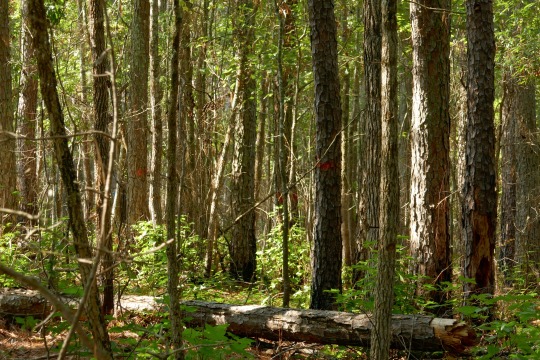
In silviculture and forest management the technique is called the hack and squirt method, because in one hand you carry a hatchet in which you hack into a tree, just deep enough to expose its living tissue, and then you squirt—either directly into the cut or onto the hatchet so that it slides down into the cut—an herbicide. In less than a year the tree will defoliate, opening up light to the ground and in subsequent years as the dead tree decays branches will break off and eventually the whole thing will fall. Much less expensive than logging, and less strenuous than chain sawing, the disadvantage of hack and squirt is that it is slower, and if done when trees are moving sap up they will push the herbicide out and go on living (likewise they can also move the herbicide down and effect trees not selected for removal). Assuming about 200 trees to an acre on his land, means he has look at over 17000 trees and decide at each one whether to leave it or kill and then later on whether to clear what has been killed (and of course in the meantime wherever the canopy opens up something is going to start growing that itself may have to be removed later). I thought about Sisyphus for a moment then I thought about Prius— “It’ll go just fine.”
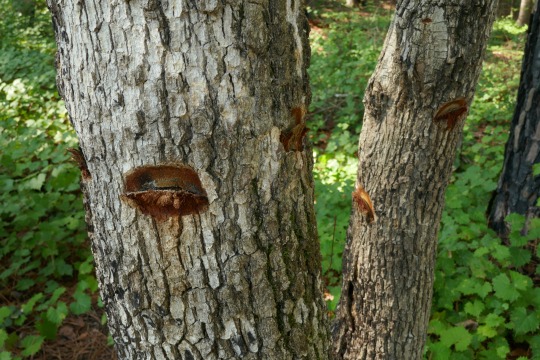
At the edge of the first woods, we came to a clearing on a hill where the shade abruptly ended and the sun touched strong on the ground, a stand of longleaf pine Tim planted fifteen years ago took every ray that fell on them, all of them eager for their next fifteen years. On the path, Brittany’s four-year-old daughter yelped with equal parts delight and dismay pointing to another hairy caterpillar, dead of life but body vibrant with the work of fire ants who, as they dismantled it also seemed to reanimate it. The path sloped downward into a mixed wood whose density was slowly being decreased by hack and squirt, by girdling and by prescribed fires—pale skeletons of holly, not a particularly flame-resistant tree, abounded, while wild grape carpeted the floor in the aftermath of burning; coteries of mushrooms white, pink, orange, giant, small sized, plump and formless proliferated near and far. Amidst it all nearly everywhere we looked were longleaf stumps and left-over longleaf branch knots. These were from old longleaf, cut maybe a century ago after growing for two, three, perhaps even four centuries before that, remnant now as the fragments of a disbanded museum. It is these pieces of the past forest that Tim’s feels warrants his efforts for taking down so many of the trees that grow there now; it was longleaf land before, and he wants it to be longleaf land again.

But it has been a while since longleaf predominated over any part of North Carolina; by the early 20th century it was almost all gone and in the intervening century, not only have other pines and many hardwoods put down roots where they were once out shaded or out fired by longleaf, but so have many other kinds of plants, some of which only began to settle the land in the same decades as Tim’s ancestor did. Emerging out of the forest, we came to another hill that was a clearing which Tim had put longleaf seedling in a few years ago—"was a clearing” for now it was a lake of Bermuda grass (introduced in the mid-18th century from Eurasia), Chinese lespedeza (introduced in 1896 from Japan) and dog fennel (a highly migrant native) that was taller than either of us. We waded in to try to find any surviving seedlings, the delicate leaves of dog fennel, feathery against the skin, breaking as we passed them releasing their odor of carrots and pepper and sweets and green tang all warming over in the sun—“Why would you want longleaf? Lay, be sweet be soft with us?” the slender poison tresses tried to tempt me. But I kept my eyes on the ground along with Tim’s, looking for the seedling trees, all still in their “grass stage” as it is called which made them nearly indistinguishable from all else around, but by parting deep the waves of green around us, we found some holding out at the bottom like benthic anemones. I was thinking what Tim soon said aloud—that the seedling there, though not dead were foregone, trees potentially one hundred feet tall cut short by herbaceous perennials that only rise to a tenth of that (though a speedy rise it is). He’ll likely have to mow the area down and try replanting the pines again.
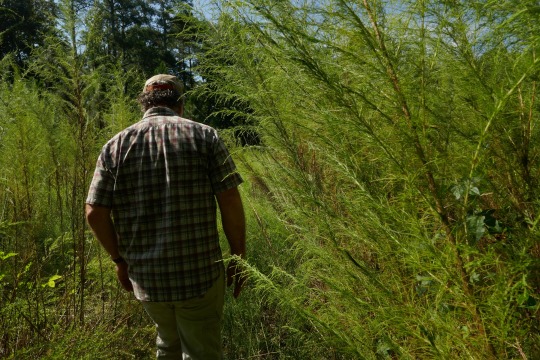
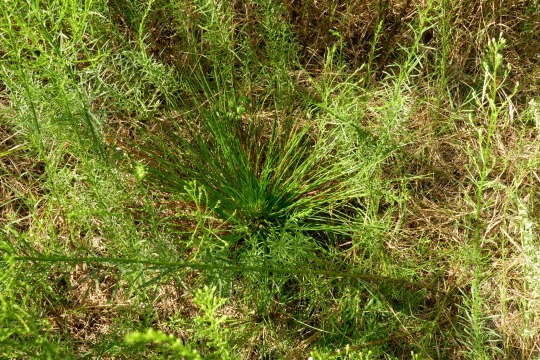
When we reemerged from the vegetal waters, stepping onto the dry land of a firebreak, Brittany and the grandkids came to say goodbye to us. She held some of the old longleaf knots in her hand, lightered knots, as they are called, good for starting fires which is what she will do with them. Her little girl had picked scuppernongs and offered one each to us, “Spit out the seeds” she said, her face covered in a make-up of mushroom fuzz, grape juice, char, sweat, soil, pine and whatever she grasped and gathered while wandering the woods—it was a kind of earthy cosmetics that might improve all our faces if we wore it. As they started back, Tim and I started down stopping mid-slope to look at the oldest grove of longleaf on the property, offspring probably from parent trees that were cut in the 19th century. Their airy crowns, unimpeded by anything above them is the way Tim wants all his longleaf to be when he looks up, but looking down to their root crowns presented a much less promising image— layers of pinecones, branches, pine straw, and the leaf litter of midstory trees all bundled up with fresh ground trailing vines. This accumulation is called duff. It occurs on any forest floor, but more accrues in a piney wood as needles decompose much slower than leaves. As a kid I often sank my hands into the duff under our loblolly pines for it was like a layer cake of cool earth, dark, dense, damp and near fully decayed at its deepest level with increasing integrity near the top, tan brown, with spent though still stiff needles interwoven. Our layers were only ever a few years old as we rotated where we raked, but Tim suspects the duff around his old longleaf has not been disturbed since the 1920s. Though certainly good for releasing nutrients back down into soil, once it becomes this thick it will not let much back up from soil, especially longleaf seedings, which need to touch bare mineral soil to germinate. Prior to the 20th century’s anti-burning forestry practices (“Only you…”), whatever duff accumulated on the ground would be burned away every few years by fires set either by storm, or more likely by hand, the hands of Native Americans before contact, and the hands of settles who learned and burned after them. The fire would trace the path of needles on the ground, burning slow and shallow, exposing the sandy soil underneath before dying at a ditch, a creek or damp ground. Setting fire to decades worth of duff however is like throwing a Molotov into a paper mill—fire hotter, higher, longer, deeper and deadlier for trees, even fire-tolerant longleaf pines. Nevertheless, Tim had tired it earlier in the year, blowing some of the duff away from the base of the trees first, in the hope that with fuel removed they would not be gridled by fire. Whether this helped or whether the trees were harmed if not lost he is still waiting to see. Most still had green needles, but we saw several green cones on the ground, cones already larger than all other kinds of pinecones in the southeast but still far from being mature and ready to be released from the tree. Had the fire caused the cones to drop prematurely? Or was it squirrels? Or was it something else entirely. Trees often answer our questions no quicker than they grow.
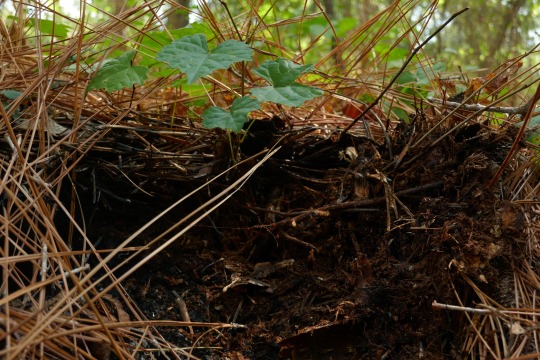
As we walked further down the hill where the fire had sat before a break, I saw a box turtle’s shell, the pattern orange and brown much like the color of duff; there was no turtle inside—not just rooted life gets eaten by the flame, though while the fire consumes individuals it also produces improved habitat for those that survive. Fire in a house is perhaps always a bad thing, but such destruction (or perhaps better “disturbance” as the ecologist calls it) out of doors almost always aids something else’s creation, spread or, in the case of longleaf, return.
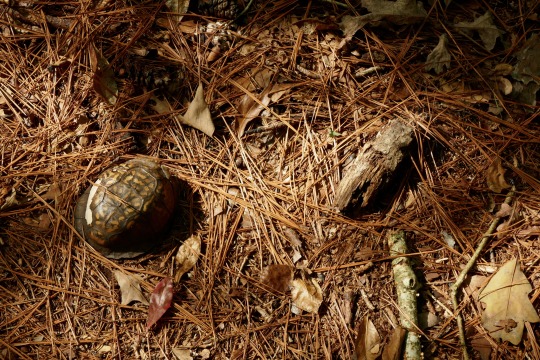
With the hill leveling out into bottomland, I could see several large white oaks. Tim never thins these out, but often the wind does by felling them, breaking the shady vault that they buttrees, light consequently flooding in. In these lambent islands Tim often plants longleaf seedling, some doing alright, though loblolly pines always find a way to sneak in around them, while the mid-story shade of sourwood—another species he is thinning out (though leaving some as a favor to bees)—reduces their growth rate. “A forester would tell you that this part of the land is supposed to be oak, sourwood, hickory and the other hardwoods” Tim said, “but all these stumps say differently.” Longleaf stumps, but also longleaf catfaces, as on the higher ground, were scattered around us, the latter raised off the ground to slow their decay so that that could remain a little longer as signs of the piney woods past—its trees and its people—those who made the catfaces on the pine for turpentine and those who maintained the swampy ground for it so that it would not be outcompeted by trees better adapted to moist sites.
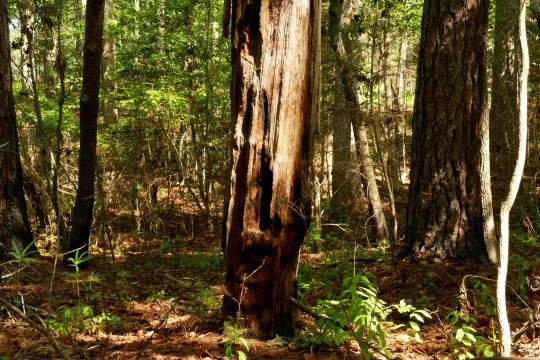
Going up once more, we came to a field of an acre or so, deep brown and dry though at its border forest trees green and crowded stood, I imagined, on their toes, not wanting to get their feet wet in the soil under that field which was all brown because of an herbicide—one of the few places that Tim had spread it broad rather than specifically. His mom, eight years away from a century of living, called him; as they spoke, I looked over the desiccated field, the slightest step into it sounded like tap-dancing on crackers. Herbicided grounds make me think of the reset option on video games, the option you reach for when you are so frustrated by lack of direction or progress on a level and you just want to start over—do it well, do it right, do it done the next time around. If it’s a really difficult level the resets might just mount until you quit, or you might finally succeed, promptly forgetting how long it took as you move to the next level. With land though we cannot quit, nor can we forget it for it always reminds us of how present challenges result from past use.
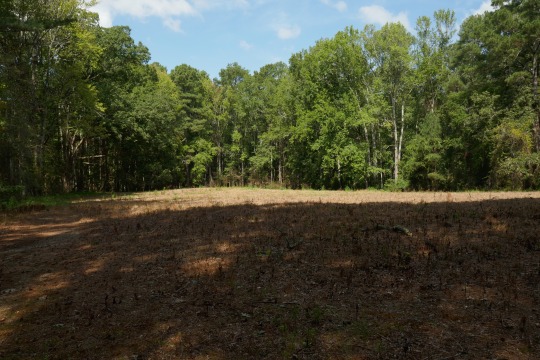
When he finished his phone call we went back into the woods and took a few steps off the trail to see the pink lady slipper orchids he planted. Only the large, paired, tongue like leaves and spent stems were present by late summer, but he showed me a photo of their very showy flowers from earlier that year. Above us, I asked about his tree stand. Back in the 1980s Tim started bowhunting, something he said was not much done at the time. To kill a deer with a bow you have to get a lot closer to it than you do with a rifle, closer than most people probably ever get near deer because either you have to be very quiet when you approach them or (more likely) when they approach you, unbeknownst to them as you wait in the stand. Once proximity is attained there comes the matter of aim. It’s not that you can aim and shoot a deer anywhere with a rifle and then proceed to catch it once it dies, but a bullet has more places it can enter for a mortal wound than an arrow does. It takes time to learn to aim a bow anywhere let alone directing it (ideally) to the deer’s broadside, between its ribs, piercing its heart and both lungs, the arrow continuing clean through the animal as if the penetration was phantasmic, the deer leaping more startled than stunned, not realizing as it stands, as it stammer, as it sits that it is dead. A record of failure is likely a bowhunter’s bounty long before the attainment of a kill. But each failure is also likely a gain for in having to just “stand and stare” while in the woods observing the ways of the prey, observing the ways of the wood, and observing oneself, one enters a kind of out school, perhaps not unlike Brittany’s. Its and education whose lessons in waiting, watching and life-taking are not dissimilar to learning to plant longleaf pines.
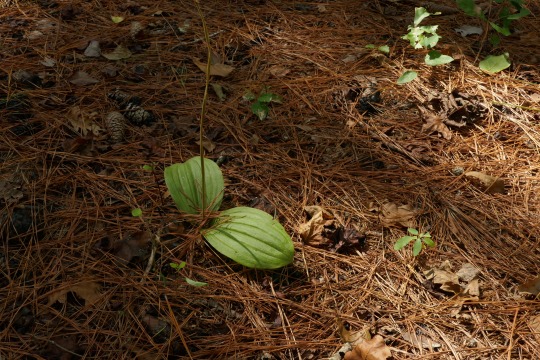
Our walk took us back downward, towards the banks of Drowning Creek, where, true to name, you could see several pieces of old longleaf “drowned” in its waters, sometimes you see less sometimes you see more, Tim told me, depending on what the beavers are doing upstream. As there was lots of rivercane around the creek banks, he asked me if I knew how it, like longleaf, once covered expanses that ground bound eyes could only ever incompletely see, in the depths of which snakes, and insects, large cats and birds like the Carolina parakeet made their lives and later lost their lives as this habitat disappeared. “If all I was doing was just for longleaf, it wouldn’t be worth it. I am doing it for everything that lived with longleaf” he told me.

Where the patch of cane ended and further on, I began to see several glass bottles, as if the remnants of a grand party from a century ago, though actually, as Tim explained, they were used to hold up netting over the tobacco crop that once grew here—now they were accidental terrariums filling with ferns. Mixed with the glass bottles were cans, labels wholly rusted, sides often busted, they once held last century’s pest- and herbicides, though unlike the glass bottles, they held nothing inside as if roots refuse to find homes in them.
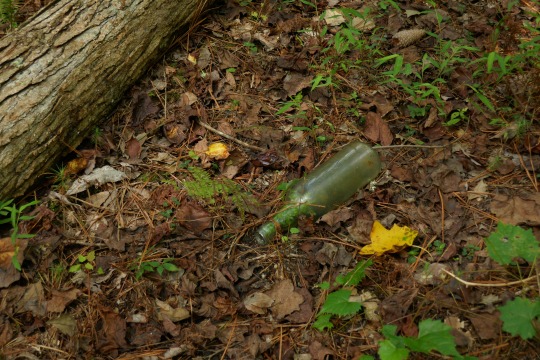
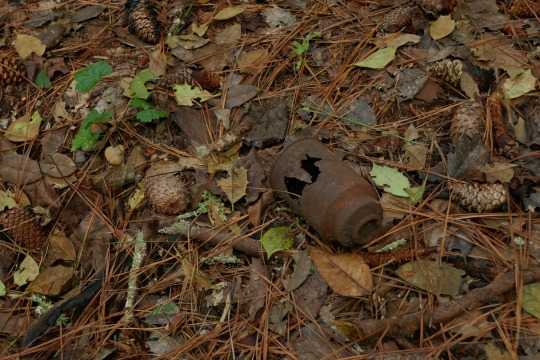
Loblolly pines, as would be expected (a loblolly is a mire), grew quite well, straight, and thick in the creek wet lowlands. I do not often like to think of trees in terms of timber but knowing that Tim wants to get rid of them for longleaf, I told him that there must be lumbermen somewhere who would take the trees. “Standing money” is what some of my folks call he said, “could probably get about $200 a trunk.” But at this point the thought of big equipment, their noise, their tracks, and the scene that follows their departure suggested an aesthetic and perhaps ethical expense a lot higher than whatever returns he would get in terms of dollars—“I recently learned about a thing they call forest bathing. When I first heard, I thought it meant literal bathing in the woods which seems strange, then I learned more about it. I feel like that is what I have been doing here all along.” I imagine Tim finishing a shift at hospital where he works as a nurse or waking up early on an off day and going outside. He has a hatchet in one hand, and a bottle in the other filled largely with water, and just a little imazapyr, the name of herbicide sounding like some ancient weapon which is this case prevents plants from ever growing again once it gets inside them. As he listens to the sounds of morning birds, he sees the long gray slight ridges of a sweet gum, two chops paired with two spits of the bottle barely rise about the volume of his next footsteps as he passes a white oak, an old loblolly he passes too, at a sourwood he pauses, ponders then the metal and bottle sound off again as they will do before a copse of red maples, and he goes on, and he goes on. Other days the bottle and hatchet lay unused, he goes out with a dibble bar and longleaf seedlings—find a spot, make a hole, plant the seedling not too low, not too high but just right into the ground to give it a chance to become a tree. He baths in a forest that he is bringing down as he sweats after another forest that he wants to raise up.
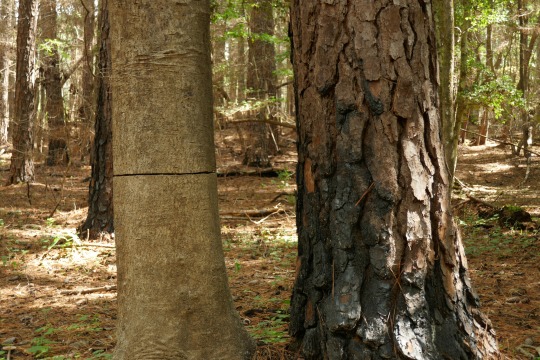
We leave the woods for the last time emerging behind the barn that sits at the edge of a large clearing on the other side of which we can see Tim’s house. The barn is made of longleaf, ashen gray as all time leached wood becomes, but still dripping resin decades later as only longleaf does in these parts. Tim’s grandfather’s tractor is in the barn, a John Deere from the 50s. It is parked facing the forest which it must have watched day by day succeed from being the fields which it had tilled, harvested, kept low. I wonder what the tractor thinks sitting there looking. Tim respects the lives his forebearers lived, but he does not think that they were good stewards of the land—letting it erode, leaving much debris, stripping the soil of its seed bank to put something in the other kind of bank with the proceeds from tobacco. Though maybe “but” does not fit above, for respecting our ancestor has to mean also criticizing them so that we can see their shortcomings not as a means to seed blame as much as recognize what the present needs in order make grounds for futures in which something will bloom. Tim knows his task will be nowhere near complete at the end of his life—just one lifetime could be spent either trying to fell and clear eighty-six acres of land or planting and tending eighty-six acres of longleaf—but perhaps that is part of the appeal, getting something started that maybe his children and grandchildren will not just remember him by but in way continue to live with him through. Even if just one longleaf that Tim plants survives to the pine’s maximum life expectancy, the Martin’s of the next four hundred years would have a direct witness to him.

It was half past noon when we returned to his house. Inside, I browsed his bookshelf full of guides on birds, plants, and the cultural history of the sandhills. We sat down and Tim handed me a brown paper bag. Written on the outside were the names of about a dozen plants, all of them associated with longleaf pine savannahs, and on the inside where their seeds and seed pods. Knowing that not much memory remains in his soils, seasonally erased by farming, whenever he can, he collects the seed of forbs and grasses from longleaf lands where that memory still blooms (or blooms anew) and he sows them under the longleaf slowly coming up around his home. A whole garden gathered in a lunch bag awaiting receptive grounds. And that was just one of them. As he had already said, he is doing this work not for a tree but for the forest it made, the forest we unmade, and the forest he is trying to make again, day by day, hack by hack, squirt by squirt, tree by tree...
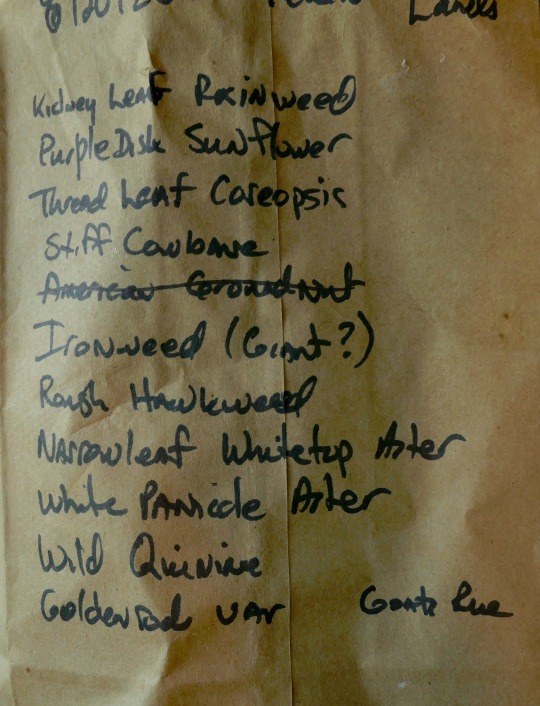
More Photos
0 notes
Text
Toyota Launches All-new bZ4X Bev
The all-new Toyota bZ4X SUV has arrived in Australian showrooms, with Toyota’s first BEV introducing a new BEV-specific platform, the latest motor generator and battery technology, and advanced safety and connected technologies. Launching in its latest global specification, the bZ4X draws on more than a quarter of a century of Toyota leadership in hybrid vehicles. The bZ4X represents another…

View On WordPress
#12.3-inch touchscreen#20-inch alloy wheels#active cruise control#advanced safety features#aerodynamic efficiency#all-electric SUV#all-wheel drive#Australian release#BEV lifestyle#BEV-specific platform#blind-spot monitor#capped-price servicing#cloud navigation#connected technologies#Crawl Control#Downhill Assist Control#driver monitor#driver’s seat memory function#driving range#dual-zone climate control#e-Axle technology#e-TNGA platform#European WLTP cycle range#exterior colours#front-wheel drive#full-service lease#hammerhead design#heated front seats#heated side mirrors#heated steering wheel
0 notes
Text

And a big ass Toyota century SUV cat
0 notes
Video
2024 TOYOTA CENTURY SUV. DESIGN INTERIOR !
0 notes